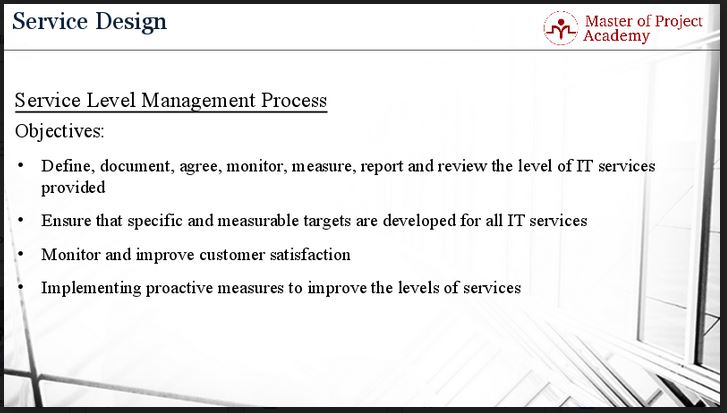Service Level Management is one of the key processes of ITIL Service Design phase of the ITIL Lifecycle for Services. During the process, expectations of the business are being evaluated. The outcomes that the IT division can deliver on based on the expectations of the business are determined, then signed off between IT and the business or the service user. ITIL online courses emphasize the importance of service level management throughout the ITIL service lifecycle; especially during the service design and continual service improvement phases. No ITIL foundation certification training would be complete without a section devoted to this process.
The service level management process has certain goals and objectives and it is important to understand how these link to driving success in an IT business.
What are the goals?
The first goal of the service level management process is ensuring that an agreed level of IT service is provided for all current IT services.
Let’s consider the money withdrawal service from an ATM of a bank. This is a critical service for the customers because a bank customer expects to get his money from his account whenever he goes to an ATM. Therefore, the business requirements of the bank might need this service to be available 99.9% of the time for its customers. The business would put the IT department up to the challenge to meet this business requirement. If the IT department of the bank can meet this availability requirement of the business with its current capabilities and resources, IT can agree to deliver this availability for the money withdrawal service. If not, more resources would have to be allocated to this critical service and the service level management process would be able to identify how much additional resources would be required to deliver this requirement.

Similarly, if a telecom operator provides live football match scores for its subscribers, the business requirement of this service may be that this service should be available 97% of the time to its users. If the IT background, resources, and capabilities of the telecom operator can deliver this availability for this service, the IT and business divisions can shake hands to agree on this service level.
Another goal of this process is ensuring that future services are delivered to agreed achievable targets. There might be a new service requirement from a business to the IT department.
For instance, a telecom operator might be aiming to send instant hot finance news via SMS to the subscribers as a new service. Before creation, publishing and delivering of this service, the IT division would have to what the business might be requiring, for example, that this service must available to its customers 98% of the time. As it is in current services, the service level management process also aims to deliver this agreed achievable targets.
What are the objectives of service level management process?
The service level management process defines, documents, agrees, monitors, measures, reports, and reviews the level of IT services provided. There can be thousands of services within an IT service provider. Depending on the services, there might be differing service level requirements, such as availability, capacity etc.
This process aims to negotiate, record, measure, and review the service levels for each service within the organization. For example, if a new service requires a significant amount of resources, older and less important services must be reviewed to determine whether fewer resources can be spent on the old service, making more resources available for the new service.
The service level management process ensures that specific measurable targets are developed for all IT services. Good, bad, fast, slow are subjective evaluations for a service.
A service can be very fast for a customer while it can be slow for another customer. Therefore specific and measurable quantitative targets must be developed for all IT services. For instance, money withdrawal service from the ATM must be completed in thirty seconds, or for a telecom operator, customer balance query service can serve up to one thousand customers concurrently. These are specific and measurable targets for services. Without specific and measurable targets, service level management cannot take place as service level agreements cannot be signed off on by the IT department and the business.

This process also aims to monitor and improve customer satisfaction. An organization is creating value by producing and delivering goods and services to its customers in order to generate revenue. In order to have a sustainable business, customers using goods and services must be satisfied. Otherwise, dissatisfied customers will be looking for a better alternative in the market and whenever they find a better choice, they will switch to a competitor. Therefore, customer satisfaction must be monitored and improved by a service provider organization progressively.
The last objective of the service level management process is implementing proactive measures to improve the levels of services. A service might be meeting its requirements and that’s fine. But measurements should be done progressively and proactively to check whether a better level can be achieved.
An organization should determine targets, try to meet these targets and then it should exceed these targets. After that, new targets should be determined and these targets should be aimed to be reached again in order to ensure continuous improvement of services and the organization respectively. This is one of the objectives of the service level management process.
Service level management is indeed one of the key parts of the Service Design phase of the ITIL Service Lifecycle. Without proper service level management, services could disintegrate into poorly performing services that do not add value to the business or worse, detracts value from the business.
Service level management ensures that services operate at a level that generates customer satisfaction and revenue, which in turn meets business objectives and targets. No IT service should be deployed without service level management so you can assess your knowledge about the service level management by taking a sample online ITIL exam.


4 thoughts on “Service Level Management: Key to Excellent IT Services”
Comments are closed.